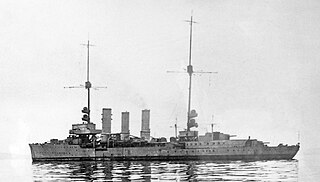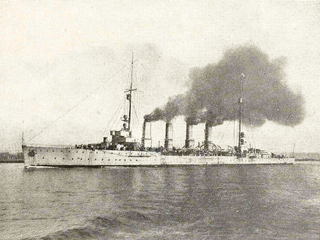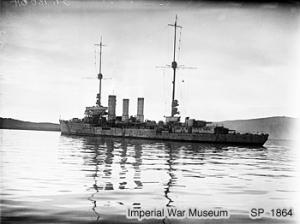
SMS Cöln was a Kolberg-class light cruiser of the German Kaiserliche Marine during the First World War. She had three sister ships, SMS Kolberg, Mainz, and Augsburg. She was built by the Germaniawerft in Kiel; her hull was laid down in 1908 and she was launched in June 1909. Cöln was commissioned into the High Seas Fleet in June 1911. She was armed with a main battery of twelve 10.5 cm SK L/45 guns and had a top speed of 25.5 kn. After her commissioning, she served with the II Scouting Group, part of the reconnaissance forces of the High Seas Fleet.

SMS Cöln was a light cruiser in the German Kaiserliche Marine, the second to bear this name, after her predecessor SMS Cöln had been lost in the Battle of Heligoland Bight. Cöln, first of her class, was launched on 5 October 1916 at Blohm & Voss in Hamburg and completed over a year later in January 1918. She and her sister Dresden were the last two light cruisers built by the Kaiserliche Marine; eight of her sisters were scrapped before they could be completed. The ships were an incremental improvement over the preceding Königsberg-class cruisers.

SMS Karlsruhe was a light cruiser of the Karlsruhe class built by the German Kaiserliche Marine. She had one sister ship, SMS Rostock; the ships were very similar to the previous Magdeburg-class cruisers. The ship was laid down in 1911, launched in November 1912, and completed by January 1914. Armed with twelve 10.5 cm SK L/45 guns, Karlsruhe had a top speed of 28.5 knots, which allowed her to escape from British cruisers during her career.

SMS Stralsund was a Magdeburg-class light cruiser of the German Kaiserliche Marine. Her class included three other ships: Magdeburg, Breslau, and Strassburg. She was built at the AG Weser shipyard in Bremen from 1910 to December 1912, when she was commissioned into the High Seas Fleet. The ship was armed with a main battery of twelve 10.5 cm SK L/45 guns and had a top speed of 27.5 knots.

SMS Strassburg was a light cruiser of the Magdeburg class in the German Kaiserliche Marine. Her class included three other ships: Magdeburg, Breslau, and Stralsund. Strassburg was built at the Kaiserliche Werft shipyard in Wilhelmshaven from 1910 to October 1912, when she was commissioned into the High Seas Fleet. The ship was armed with a main battery of twelve 10.5 cm (4.1 in) SK L/45 guns and had a top speed of 27.5 knots.

The Scharnhorst class was the last class of traditional armored cruisers built by the German Kaiserliche Marine. The class comprised two ships, Scharnhorst and Gneisenau. They were larger than the Roon-class cruisers that preceded them; the extra size was used primarily to increase the main armament of 21 cm (8.2 inch) guns from four to eight. The ships were the first German cruisers to reach equality with their British counterparts. The ships were named after 19th century Prussian army reformers, Gerhard von Scharnhorst and August von Gneisenau.

SMS Dresden was the second and final ship of the Cöln class of light cruisers to be completed and commissioned in the Kaiserliche Marine. The ship was laid down in 1916 and launched on 25 April 1917; she was commissioned into the High Seas Fleet on 28 March 1918. She and her sister Cöln were the only two of her class to be completed; eight of her sisters were scrapped before they could be completed. The ships were an incremental improvement over the preceding Königsberg-class cruisers.

The Wiesbaden class of light cruisers was a class of ships built by the German Kaiserliche Marine shortly before the outbreak of World War I. Two ships were built in this class, Wiesbaden and Frankfurt. They were very similar to the preceding design, the Graudenz class, though they were armed with eight 15 cm SK L/45 guns instead of the twelve 10.5 cm SK L/45 guns on the earlier vessels. The ships had a top speed of 27.5 knots.

The Brummer class consisted of two light mine-laying cruisers built for the Imperial German Navy in World War I: SMS Brummer and SMS Bremse. When the war broke out, the Germans had only two older mine-laying cruisers. Although most German cruisers were fitted for mine-laying, a need for fast specialized ships existed. The Imperial Russian Navy had ordered sets of steam turbines for the first two ships of the Svetlana-class cruisers from the AG Vulcan shipyard in Stettin. This machinery was confiscated on the outbreak of war and used for these ships. Both vessels were built by AG Vulcan.

The Königsberg class of light cruisers was a group of four ships commissioned into Germany's Kaiserliche Marine shortly before the end of World War I. The class comprised Königsberg, Karlsruhe, Emden, and Nürnberg, all of which were named after light cruisers lost earlier in the war. The ships were an incremental improvement over the preceding Wiesbaden-class cruisers, and were armed with a main battery of eight 15 cm (5.9 in) SK L/45 guns and had a designed speed of 27.5 knots.

SMS Königsberg was the lead ship of the Königsberg class of light cruisers, built for the German Kaiserliche Marine during World War I. She took the name of the earlier Königsberg, which had been destroyed during the Battle of Rufiji Delta in 1915. The new ship was laid down in 1914 at the AG Weser shipyard, launched in December 1915, and commissioned into the High Seas Fleet in August 1916. Armed with eight 15 cm SK L/45 guns, the ship had a top speed of 27.5 kn.

SMS Karlsruhe was a light cruiser of the Königsberg class, built for the Kaiserliche Marine during World War I. She was named after the earlier Karlsruhe, which had sunk in November 1914, from an accidental explosion. The new cruiser was laid down in 1914 at the Kaiserliche Werft shipyard in Kiel, launched in January 1916, and commissioned into the High Seas Fleet in November 1916. Armed with eight 15 cm SK L/45 guns, the ship had a top speed of 27.5 kn.

SMS Rostock was a light cruiser of the Karlsruhe class built by the German Kaiserliche Marine. She had one sister ship, SMS Karlsruhe; the ships were very similar to the previous Magdeburg-class cruisers. The ship was laid down in 1911, launched in November 1912, and completed by February 1914. Armed with twelve 10.5 cm SK L/45 guns, Rostock had a top speed of 28.5 knots and displaced 6,191 t at full load.

The Karlsruhe class of light cruisers was a pair of two ships built for the German Imperial Navy before the start of World War I. The ships—SMS Karlsruhe and Rostock—were very similar to the previous Magdeburg-class cruisers, mounting the same armament and similar armor protection, though they were larger and faster than the earlier ships. Both vessels were laid down in 1911, and launched one day apart, on 11 and 12 November 1912. Karlsruhe joined the fleet in January 1914, but fitting out work lasted slightly longer on her sister; Rostock was commissioned the following month.

The Magdeburg class of light cruisers was a group of four ships built for the Imperial German Navy. The class comprised SMS Magdeburg, the lead ship, Breslau, Strassburg, and Stralsund. All four ships were laid down in 1910 and were completed by the end of 1912. They were armed with a main battery of twelve 10.5 cm guns, though over the course of their careers, Breslau, Strassburg, and Stralsund were rearmed with more powerful 15 cm guns. They displaced 4,570 t at full load and were rated at a top speed of 27.5 knots, though all four vessels exceeded that figure on trials.

SMS Nürnberg was a Königsberg-class light cruiser built during World War I by Germany for the Imperial Navy. She had three sisters: Königsberg, Karlsruhe, and Emden. The ship was named after the previous light cruiser Nürnberg, which had been sunk at the Battle of the Falkland Islands. The new cruiser was laid down in 1915 at the AG Weser shipyard in Bremen, launched in April 1916, and commissioned into the High Seas Fleet in February 1917. Armed with eight 15 cm (5.9 in) SK L/45 guns, the ship had a top speed of 27.5 kn.

SMS Emden was a German light cruiser belonging to the Königsberg class, built during the First World War. Emden served in the German Kaiserliche Marine until the end of the war, at which point she was ceded to France. The ship was named after the previous Emden, which had been destroyed at the Battle of Cocos earlier in the war. She mounted an Iron Cross on her stem-head in honor of the earlier Emden. The new cruiser was laid down in 1914 at the AG Weser shipyard in Bremen, launched in February 1916, and commissioned into the High Seas Fleet in December 1916. Armed with eight 15 cm SK L/45 guns, the ship had a top speed of 27.5 kn.

The Graudenz class of light cruisers was a class of two ships built for the Imperial German Navy. The class comprised SMS Graudenz and SMS Regensburg. The ships both were laid down in 1912, launched in October 1913 and April 1914 and commissioned in August 1914 and January 1915, respectively. They were armed with a main battery of twelve 10.5 cm (4.1 in) guns, though over the course of their careers, they were rearmed with seven more powerful 15 cm (5.9 in) guns. They displaced 6,382 t at full load and were rated at a top speed of 27.5 knots

The Kolberg class was a group of four light cruisers built for the German Imperial Navy and used during the First World War. The class comprised four vessels: SMS Kolberg, the lead ship, Mainz, Cöln, and Augsburg. The ships were built between 1908 and 1910, and two, Kolberg and Augsburg, were modernized in 1916–1917. The ships were armed with a main battery of twelve 10.5 cm SK L/45 guns and had a design speed of 25.5 knots. The first three ships were assigned to the reconnaissance forces of the High Seas Fleet; Augsburg was instead used as a torpedo and gunnery training ship.
















